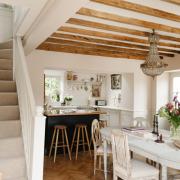The art on my walls ranges from a poster for Cotswold entertainment institution Gifford’s Circus, engravings of alpine winter scenes on scraperboard and a nude composed of acrylic and foils on linen dipped in resin to delicate painted silks of peacocks and bedecked elephants, a muted watercolour of an Andalusian doorway and a print of a woman lying in bed, enveloped in duvets, her face obscured by a book.
Every piece has a unique meaning to me. The circus poster, bespoke framed in shocking pink, was a housewarming present bringing impish energy, and a nod to a visit to the big top, to a new life chapter. The engravings are, incredibly given their detail, works made by my late mum when she was just 16. The nude was an unexpected thank you gift from a friend for a completed collaborative project – the digital launch of ArtÓ art gallery in Stow-on-the-Wold.
The silks travelled back from Jaipur, India, where I drank coffee in the gentle morning heat of a shady garden near skulking peacocks and came nose to trunk with painted elephants during the Elephant Festival. The watercolour, family legend has it, is of the door to a house where my grandmother lived in Granada and which my dad and I once tried to find. The reading woman was a birthday present from my siblings because my sister ‘saw it and thought of you’.

Each artwork evokes different memories, some crystalised and others complex, and carries different emotional tags, stoking up feelings of joy with a hint of defiance, pride mixed with regret, surprised gratitude, the spirit of adventure, nostalgia, sadness or warm support. They’re subjective responses, which morph over time, and don’t necessarily bear any resemblance to the artist or illustrator’s original intention.
That is the power of art. Its ability to reach out and grab the viewer, from across the length of the Centaur at the Fresh Art Fair, amidst the buzz of the Broadway Arts Festival or jockeying for position on a gallery wall. Is it the artwork’s ‘aura’ at play or its willingness to accept another paint layer or patina as we attach our own significance that draws us in? Either way, somehow the buyer has that ‘yes, this one’ moment and once the decision is made it’s like crossing the Rubicon.
The psychology of buying art is both primitive and multifaceted and observing it in action is one of the things I love most about working in an art gallery. Stow-on-the-Wold is well known as an arty hub and the people who wander into ArtÓ in its historic Brewery Yard range from curious foreign tourists and in-the-know day trippers to those relocating or renovating homes with new or reimagined walls to fill. For them art becomes a visual memento of an experience or a way of bedding into a new space.

People’s behaviour in the gallery varies from arriving with post-it notes of pre-determined dimensions for an artwork to fulfil to those on the border of laughter and mild panic wondering where on earth to hang the piece bought on impulse that just became their most treasured possession. One of my favourite encounters was watching a dynamic family of five choose a vibrant abstract acrylic, ‘Diversity’ by Cheltenham-based artist Silvia O’Neill, for their sitting room in the most extraordinary act of democracy. The name seemed curiously fitting.
In a way buying art is a huge leap of faith. ‘Diversity’ had hung on a white wall next to a full-size orange phone box, part of the unapologetically maverick vibe at ArtÓ, and yet the family were able to readily transpose it – with the help of our Smartist software to ratify the in-gallery decision – onto the charcoal chimney breast of their London sitting room. Seeing photos of it later installed in their home, their gut instincts were proved right.
Because we have an ‘owned not loaned’ ethos at ArtÓ and support artists by buying their work upfront (on the beautifully basic premise that in doing so they can carry on doing what they do best), an artwork’s first home is actually the gallery wall. It feels slightly heart wrenching, but also deeply heart warming, when it finds its way out of the door, especially when we’ve commissioned a piece, such as the ‘Icons’ series by William Thomas, which includes a chopper bike and Rubik’s cube.
Knowing an artwork that catches someone’s eye may end up in their family living space, bedroom sanctuary or ‘man cave’ (what’s the female equivalent I wonder?), I like to give visitors space and time to enjoy the art in the gallery in their own way, making a connection that will endure. Encouraging a relaxed, feeling approach to art prompts lovely two-way interactions and I often learn of artists I’ve not heard of before whose work might have a synergy of subject or style with pieces we have on display.
Gifting art adds a further intriguing variable to the buying process, and watching this play out is just as rewarding. I’ve seen one half of a couple buy a piece of art for the other on the spot in the guise of recognising an upcoming milestone birthday and a new start in a new home, but in reality due to their shared moment in the art gallery. I’ve observed a fiancée happen upon the perfect wedding present and performed an elaborate but subtle dance of winks and gestures to organise the delivery of surprise gifts after a gallery visit.
I’ve also witnessed someone fall in love with an artwork with a very personal resonance to them reluctantly walk away from it, feeling almost compelled to take it off the wall and run out of the gallery and give it to her myself. I have a hunch that while the ultimate destiny of the painting – a photorealistic watercolour of the Parisienne cafe Les Deux Magots by Nur Ilham – wasn’t to live in her home, it will have left its mark in her mind and in turn a little of her energy remains floating around the piece.

I have huge respect for the skill of pairing art with interior design (we’ve loaned artworks to Cotswold designers Louise Jackson Interiors and worked with The House Ministry in Cheltenham to show their clients how art can elevate a wall) and have no doubt that art can be a prudent investment. What makes visual art unique however is the conversations that linger around it, sometimes had over several generations. The artists we feature at ArtÓ are always delighted to know that a piece they’ve poured their soul into has made an impact on someone and found its way into their heart and home.
If I was asked what to look for in an artwork, I wouldn’t focus on medium or provenance, whether a piece was an original or a print, or even necessarily the skill in its execution. I’d ask this. ‘Will you remember where you were when you bought it? Who you were with? What you felt? Did receiving it from or gifting it to someone else enrich the relationship with that person? If you can bottle this essence of an artwork, and allow for a little added alchemy over time, then you’ve truly discovered the value of art.



























